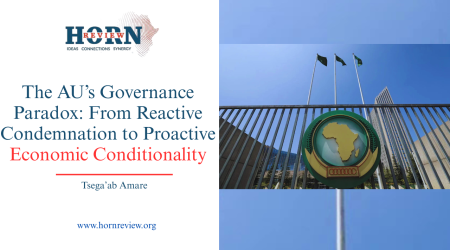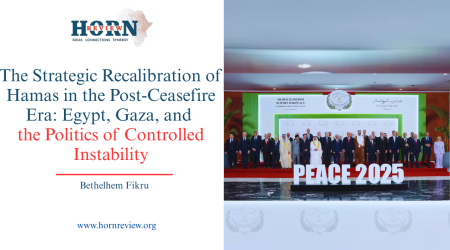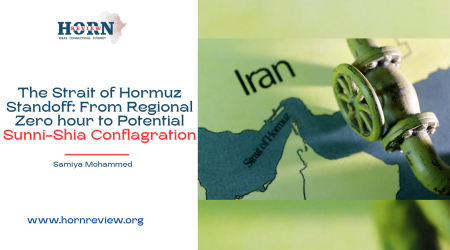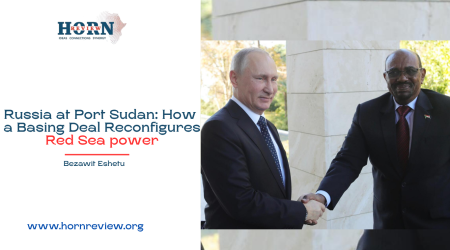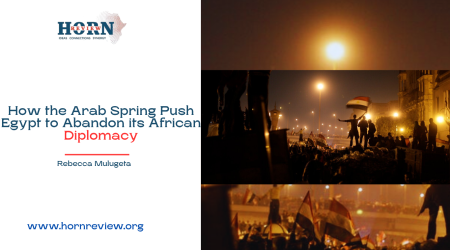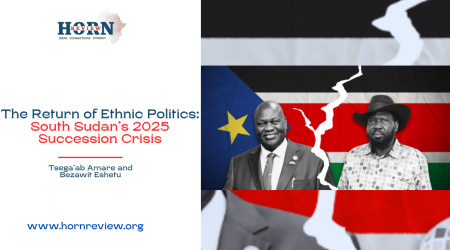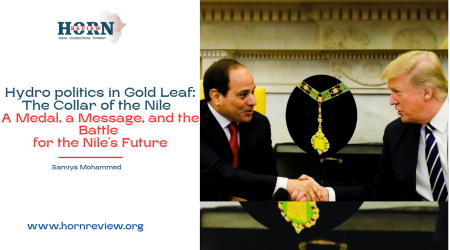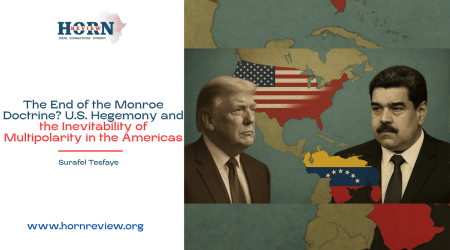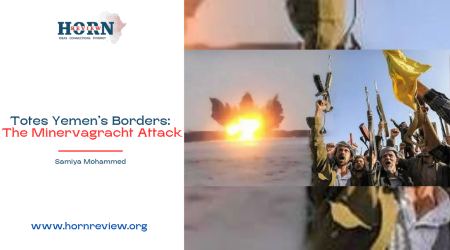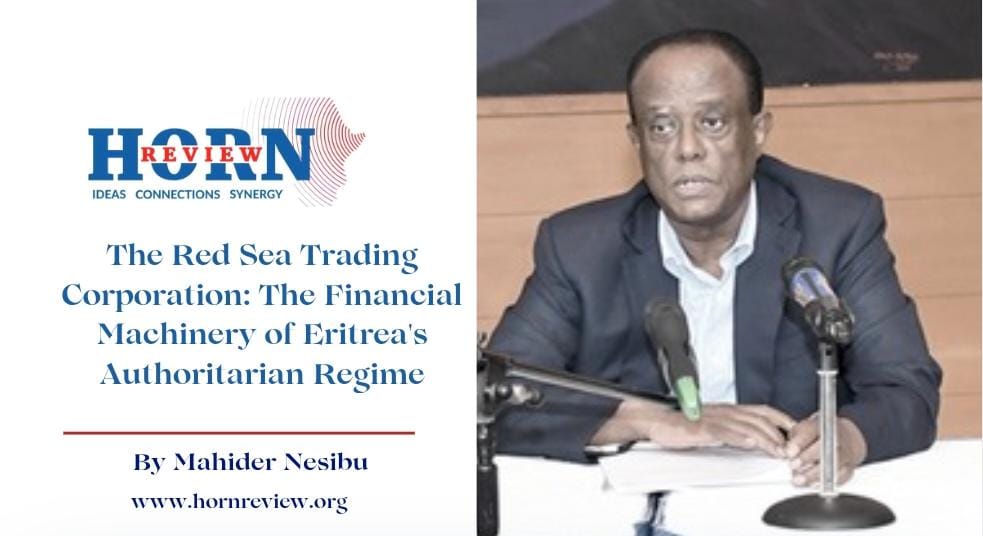
27
Oct
The Red Sea Trading Corporation: The Financial Machinery of Eritrea’s Authoritarian Regime
When the then–U.S. representative in Asmara, Ambassador Scott H. DeLisi, sent a cable to Washington in 2006, he described a financial system as opaque as it was formidable. What he observed was an economic system centred around the People’s Front for Democracy and Justice (PFDJ). Through an intricate web of trusts, companies, and state enterprises, Eritrea’s ruling elite had perfected a mechanism of control that DeLisi described as a strategy of “controlling the market, controlling the people.”
The ambassador’s dispatch remains one of the few unfiltered records of Eritrea’s internal financial structure. It captures the architecture of an economy built to consolidate power and fuel survival. Much has been written about the repression and militarization that define Eritrean political life. Far less attention has been given to the regime’s financial foundations. That omission reflects both the opacity of the system and the risks of speaking about it. The PFDJ’s finances are treated as a matter of state security, guarded by secrecy and silence. Yet the limited information available reveals an economic structure carefully built to sustain political dominance through total control of resources.
Eritrea’s economy is not an independent sphere but a direct extension of the regime’s authority. What little productive activity exists functions under the supervision of the ruling party. This economic centralization ensures the state’s survival even as public institutions decay. Gaim Kibreab, in Eritrea: A Dream Deferred, describes the system with precision. “The Office of Economic Affairs holds and manages the totality of the share-capital investment…Hagos Gebrehiwet, one of the closest allies of the party’s chairman and head of state, heads it”. The PFDJ dominates nearly every sector through a network of firms engaged in manufacturing, trade, and services.
At the core of this structure stands the Red Sea Trading Corporation (RSTC), the principal source of foreign exchange and the country’s only authorized importer and exporter. Kibreab notes that since 2002, RSTC has been the sole firm licensed to import key commodities such as flour, cement, and sugar. By 2004, all import activity was consolidated under its authority. No private enterprise is permitted to compete. This monopoly channels all hard currency into PFDJ-controlled accounts, creating a financial system entirely dependent on the party. Despite its central role, the Red Sea Trading Corporation has no public profile. It maintains no website, publishes no records, and leaves almost no trace online. For a company that manages Eritrea’s international trade, this absence is telling. It reflects the covert nature of its operations and the system of finance and trade on which the regime relies.
These operations fall under the broader umbrella of the Hidri Trust, a holding structure created in 1995 as the Eritrean People’s Liberation Front transformed into the PFDJ. Hidri absorbed the EPLF’s wartime assets and formalized them under party control. In practice, it became the instrument through which Isaias Afwerki and Hagos Gebrehiwet managed the regime’s economic empire. Those who once shared authority were gradually removed or disappeared from public life. The Trust’s, true to its foundation, worked to make the state the sole employer and the people economically dependent on the party.
The 2025 U.S. Department of State Investment Climate Report describes Eritrea’s economy with cautious diplomacy but unmistakable clarity. It notes that the few foreign enterprises operating in the country do so under private agreements negotiated directly with a small circle of officials representing both the government and the PFDJ. The mining sector is dominated by joint ventures between foreign companies and the state-owned Eritrean National Mining Corporation (ENAMCO), while large domestic enterprises are either owned by the PFDJ or jointly managed with it. State-owned entities benefit from privileges unavailable to private actors, including the exclusive right to import and export through RSTC. Such arrangements demonstrate that the Government of the State of Eritrea (GSE) and the PFDJ function as a single entity. The result is neither a socialist nor a liberal economy. It is a closed and extractive system designed to serve the ruling elite.
The role of the RSTC was formally acknowledged in U.S. sanctions imposed during the Tigray conflict. The sanctions designation described RSTC as “managing the property and financial interests of the PFDJ, funding its activities, and providing it with business assistance”. This identification placed RSTC at the heart of the regime’s financial machinery. By controlling the entry and exit of goods, RSTC manages Eritrea’s hard currency. It is through this institution that the PFDJ accumulates foreign exchange to sustain its military expenditures and regional operations. During the Tigray conflict, RSTC functioned as the financier of Eritrea’s military engagement. Should another operation arise, the same channels would likely be used again. Its function, therefore, extends well beyond commerce. It is the financial engine of the regime’s political and military ambitions.
Ambassador DeLisi’s 2006 cable offered a rare window into the functioning of the Hidri Trust. He used the construction company Segun as an example of how the Trust consolidates control. Segun, he wrote, was the largest construction firm in the country, responsible for government projects and housing in Asmara sold to the diaspora for up to half a million dollars. Buyers were required to pay in hard currency. DeLisi observed that Segun’s access to cheap labour from national service recruits and its privileged ability to import construction materials allowed it to undercut the few remaining private firms. The company’s profits were sustained by an artificial market environment that favoured Hidri-owned enterprises and eliminated competition. In his conclusion, DeLisi remarked that although secrecy surrounded the Trust, its power in Eritrea’s economy was unmistakable.
This concentration of control through Hidri binds the country’s main enterprises into a closed system that recycles resources within the ruling party. The structure ensures that wealth creation remains confined to the political elite while the wider population remains economically dependent and politically subdued. At the centre of this network stands Hagos Gebrehiwet Woldekidan, Head of Economic Affairs of the PFDJ and Chief Executive Officer of RSTC. He is the regime’s chief financier and one of President Isaias Afwerki’s most trusted lieutenants. According to African Arguments, Hagos managed to shield the regime from the impact of UN sanctions through covert operations, manipulation of informal trade, and the use of international intermediaries to move funds outside formal banking systems. The Africa Report similarly notes that he oversees state-owned enterprises, the finance ministry, and the regime’s principal sources of income. Only he and the president are said to have full access to financial information. Hagos also chairs ENAMCO, supervising mining projects and the export of gold and potash, including revenues from the Bisha Mining Project. He manages the two-percent diaspora tax levied on Eritreans abroad and reports directly to Isaias on all expenditures. His role places him at the intersection of state, party, and private enterprise, a position that makes him indispensable to the regime’s financial stability.
Control over foreign currency forms another pillar of the regime’s endurance. Amal Stefanos writes that, the diaspora tax, initially introduced as a patriotic contribution for reconstruction, has long become a permanent levy. The proceeds are used to sustain the government’s security apparatus and foreign interventions rather than public welfare. Combined with the RSTC’s monopoly on trade, the exploitation of national service labour, and mining revenues, this taxation system reinforces a circular economy that serves political control instead of development.
The system that links the Red Sea Trading Corporation, the Hidri Trust, and the PFDJ’s governing structure remains deeply opaque. Yet the evidence available points to an economy functioning as a financial arm of an entrenched political order. This structure deserves closer scrutiny. Governments and firms engaging with Eritrea must consider where their investments flow and whose authority they reinforce. For neighbouring states confronting the consequences of Asmara’s regional ventures, understanding the financial base that sustains such policies is equally crucial. The RSTC and the figure of Hagos Gebrehiwet occupy the core of this apparatus. Examining their operations, through an effective intelligence mechanism, is essential to grasp how Eritrea’s economy sustains its power at home and projects influence abroad.
By Mahder Neisbu, Researcher, Horn Review

